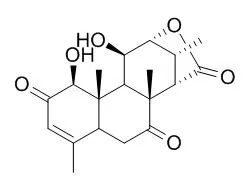| In vitro: |
| Nat Prod Commun. 2010 Jul;5(7):1009-12. | | Cytotoxic activity of quassinoids from Eurycoma longifolia.[Pubmed: 20734929 ] |
METHODS AND RESULTS:
Twenty-four quassinoids isolated from Eurycoma longifolia Jack were investigated for their cytotoxicity against a panel of four different cancer cell lines, which includes three murine cell lines [colon 26-L5 carcinoma (colon 26-L5), B16-BL6 melanoma (B16-BL6), Lewis lung carcinoma (LLC)] and a human lung A549 adenocarcinoma (A549) cell line.
CONCLUSIONS:
Among the tested compounds, Eurycomalactone (9) displayed the most potent activity against all the tested cell lines; colon 26-L5 (IC50 = 0.70 microM), B16-BL6 (IC50 = 0.59 microM), LLC (IC50 = 0.78 microM), and A549 (IC50 = 0.73 microM). These activities were comparable to clinically used anticancer agent doxorubicin (colon 26-L5, IC50 = 0.76 microM; B16-BL6, IC50 = 0.86 microM; LLC, IC50 = 0.80 microM; A549, IC50 = 0.66 microM). | | Fitoterapia. 2010 Oct;81(7):669-79. | | Tongkat Ali (Eurycoma longifolia Jack): a review on its ethnobotany and pharmacological importance.[Pubmed: 20434529] | Eurycoma longifolia Jack is an herbal medicinal plant of South-East Asian origin, popularly recognized as 'Tongkat Ali.' The plant parts have been traditionally used for its antimalarial, aphrodisiac, anti-diabetic, antimicrobial and anti-pyretic activities, which have also been proved scientifically.
METHODS AND RESULTS:
The plant parts are rich in various bioactive compounds (like eurycomaoside, eurycolactone, Eurycomalactone, eurycomanone, and pasakbumin-B) among which the alkaloids and quassinoids form a major portion.
Even though toxicity and safety evaluation studies have been pursued, still a major gap exists in providing scientific base for commercial utilization and clearance of the Tongkat Ali products with regard to consumer's safety.
CONCLUSIONS:
The present review aims at reviewing the research works undertaken till date, on this plant in order to provide sufficient baseline information for future works and for commercial exploitation. | | J Ethnopharmacol. 2004 Jun;92(2-3):223-7. | | Antiplasmodial studies of Eurycoma longifolia Jack using the lactate dehydrogenase assay of Plasmodium falciparum.[Pubmed: 15138004 ] |
The roots of Eurycoma longifolia Jack have been used as traditional medicine to treat malaria.
METHODS AND RESULTS:
A systematic bioactivity-guided fractionation of this plant was conducted involving the determination of the effect of its various extracts and their chemical constituents on the lactate dehydrogenase activity of in vitro chloroquine-resistant Gombak A isolate and chloroquine-sensitive D10 strain of Plasmodium falciparum parasites. Their antiplasmodial activity was also compared with their known in vitro cytotoxicity against KB cells. Four quassinoids, eurycomanone (1), 13,21-dihydroeurycomanone (3), 13 alpha(21)-epoxyeurycomanone (4), Eurycomalactone (6) and an alkaloid, 9-methoxycanthin-6-one (7), displayed higher antiplasmodial activity against Gombak A isolate but were less active against the D10 strain when compared with chloroquine.
CONCLUSIONS:
Amongst the compounds tested, 1 and 3 showed higher selectivity indices obtained for the cytotoxicity to antiplasmodial activity ratio than 14,15 beta-dihydroxyklaineanone (2), eurycomanol (5), 6 and 7. |
|






 Cell. 2018 Jan 11;172(1-2):249-261.e12. doi: 10.1016/j.cell.2017.12.019.IF=36.216(2019)
Cell. 2018 Jan 11;172(1-2):249-261.e12. doi: 10.1016/j.cell.2017.12.019.IF=36.216(2019) Cell Metab. 2020 Mar 3;31(3):534-548.e5. doi: 10.1016/j.cmet.2020.01.002.IF=22.415(2019)
Cell Metab. 2020 Mar 3;31(3):534-548.e5. doi: 10.1016/j.cmet.2020.01.002.IF=22.415(2019) Mol Cell. 2017 Nov 16;68(4):673-685.e6. doi: 10.1016/j.molcel.2017.10.022.IF=14.548(2019)
Mol Cell. 2017 Nov 16;68(4):673-685.e6. doi: 10.1016/j.molcel.2017.10.022.IF=14.548(2019)